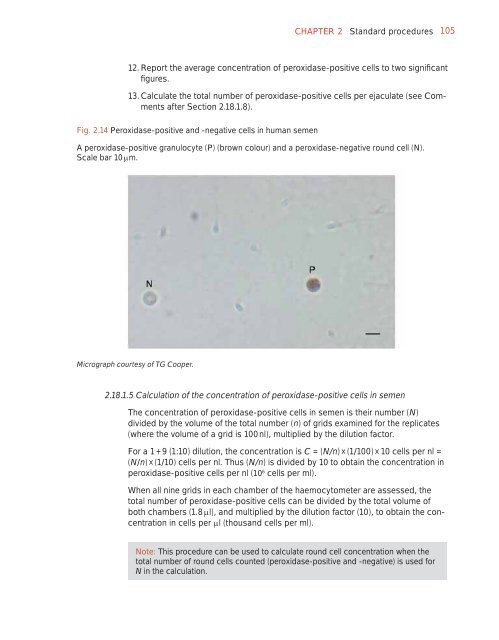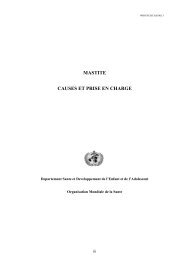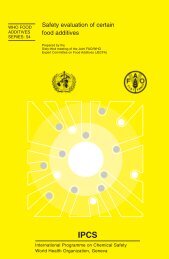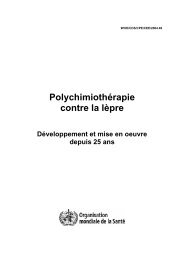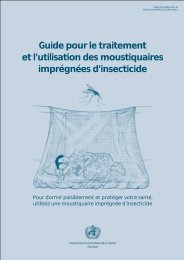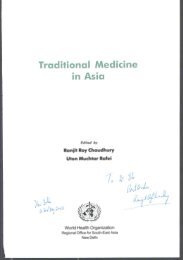- Page 1 and 2:
WHO laboratory manual for the Exami
- Page 3 and 4:
WHO Library Cataloguing-in-Publicat
- Page 5 and 6:
iv 2.8 Routine counting procedure 3
- Page 7 and 8:
vi 5.5 Discontinuous density gradie
- Page 9 and 10:
viii Appendix 7 Sampling errors and
- Page 11 and 12:
x TABLES Table 2.1 Acceptable diffe
- Page 13 and 14:
xii Mr Godwin E Imade Department of
- Page 15 and 16:
xiv HSA HTF IB IBT ICSI Ig IM IQC I
- Page 17 and 18:
2 CHAPTER 1 Background The main fea
- Page 20:
PART I. Semen analysis
- Page 23 and 24:
8 PART I Semen analysis losing
- Page 25 and 26:
10 PART I Semen analysis
- Page 27 and 28:
12 PART I Semen analysis 2.2.5 Coll
- Page 29 and 30:
14 PART I Semen analysis 2.3.1.1 De
- Page 31 and 32:
16 PART I Semen analysis Comment 1:
- Page 33 and 34:
18 PART I Semen analysis Box 2.3 Th
- Page 35 and 36:
20 PART I Semen analysis Note: Moti
- Page 37 and 38:
22 PART I Semen analysis Note 1: Th
- Page 39 and 40:
24 PART I Semen analysis Note 2: If
- Page 41 and 42:
26 PART I Semen analysis 35%. The m
- Page 43 and 44:
28 PART I Semen analysis 8. Evaluat
- Page 45 and 46:
30 PART I Semen analysis 6. Tally t
- Page 47 and 48:
32 PART I Semen analysis 2.6.3.3 Sc
- Page 49 and 50:
34 PART I Semen analysis 2.7.1 Type
- Page 51 and 52:
36 PART I Semen analysis Fig. 2.8 W
- Page 53 and 54:
38 PART I Semen analysis Box 2.8 Ac
- Page 55 and 56:
40 PART I Semen analysis Use a pos
- Page 57 and 58:
42 PART I Semen analysis Table 2.4
- Page 59 and 60:
44 PART I Semen analysis The concen
- Page 61 and 62:
46 PART I Semen analysis Plac
- Page 63 and 64:
48 PART I Semen analysis 2.11 When
- Page 65 and 66:
50 PART I Semen analysis Table 2.5
- Page 67 and 68:
52 PART I Semen analysis 2.11.2 Ass
- Page 69 and 70: 54 PART I Semen analysis Box 2.13 V
- Page 71 and 72: 56 PART I Semen analysis the concen
- Page 73 and 74: 58 PART I Semen analysis Fig. 2.10
- Page 75 and 76: 60 PART I Semen analysis Note 3: Be
- Page 77 and 78: 62 PART I Semen analysis Note 1: If
- Page 79 and 80: 64 PART I Semen analysis 2.14.2.2 F
- Page 81 and 82: 66 PART I Semen analysis 2.14.3.3 S
- Page 83 and 84: 68 PART I Semen analysis Spermatozo
- Page 85 and 86: 70 PART I Semen analysis Fig. 2.13
- Page 87 and 88: 72 PART I Semen analysis 10 microns
- Page 89 and 90: 74 PART I Semen analysis 10 microns
- Page 91 and 92: 76 PART I Semen analysis 10 microns
- Page 93 and 94: 78 PART I Semen analysis 10 microns
- Page 95 and 96: 80 PART I Semen analysis 10 microns
- Page 97 and 98: 82 PART I Semen analysis 10 microns
- Page 99 and 100: 84 PART I Semen analysis 10 microns
- Page 101 and 102: 86 PART I Semen analysis 10 microns
- Page 103 and 104: 88 PART I Semen analysis 10 microns
- Page 105 and 106: 90 PART I Semen analysis 10 microns
- Page 107 and 108: 92 PART I Semen analysis 10 microns
- Page 109 and 110: 94 PART I Semen analysis 10 microns
- Page 111 and 112: 96 PART I Semen analysis 15 microns
- Page 113 and 114: 98 PART I Semen analysis 15 microns
- Page 115 and 116: 100 PART I Semen analysis Comp
- Page 117 and 118: 102 PART I Semen analysis 2.17.6 As
- Page 119: 104 PART I Semen analysis 2. Remove
- Page 123 and 124: 108 PART I Semen analysis Nuclear s
- Page 125 and 126: 110 PART I Semen analysis 9. Repeat
- Page 127 and 128: 112 PART I Semen analysis 1. Mix th
- Page 129 and 130: 114 PART I Semen analysis 4. Includ
- Page 131 and 132: 116 PART I Semen analysis The SDI
- Page 133 and 134: 118 PART I Semen analysis 3.2.2 Rea
- Page 135 and 136: 120 PART I Semen analysis 5. Calcul
- Page 137 and 138: 122 PART I Semen analysis 3.3 Inter
- Page 139 and 140: 124 PART I Semen analysis Box 3.2 V
- Page 141 and 142: 126 PART I Semen analysis mid-cycle
- Page 143 and 144: 128 PART I Semen analysis Fig. 3.2
- Page 145 and 146: 130 PART I Semen analysis Poor-qual
- Page 147 and 148: 132 PART I Semen analysis 2. Reject
- Page 149 and 150: 134 PART I Semen analysis 4. Replic
- Page 151 and 152: 136 PART I Semen analysis 7. Stop i
- Page 153 and 154: 138 PART I Semen analysis recording
- Page 155 and 156: 140 PART I Semen analysis 3.5.3 Use
- Page 157 and 158: 142 CHAPTER 4 Research procedures W
- Page 159 and 160: 144 PART I Semen analysis 6. Phorbo
- Page 161 and 162: 146 PART I Semen analysis Fig. 4.2
- Page 163 and 164: 148 PART I Semen analysis 3. NaCl,
- Page 165 and 166: 150 PART I Semen analysis Fig. 4.3
- Page 167 and 168: 152 PART I Semen analysis 4.4.2.4 Q
- Page 169 and 170: 154 PART I Semen analysis 5. Establ
- Page 171 and 172:
156 PART I Semen analysis 4.5.1.7 C
- Page 173:
PART II. Sperm preparation
- Page 176 and 177:
162 PART I I Sperm preparation and
- Page 178 and 179:
164 PART I I Sperm preparation Note
- Page 180 and 181:
166 PART I I Sperm preparation 6. G
- Page 182 and 183:
168 PART I I Sperm preparation 5. P
- Page 184 and 185:
170 PART I I Sperm preparation Box
- Page 186 and 187:
172 PART I I Sperm preparation Note
- Page 188 and 189:
174 PART I I Sperm preparation 1. P
- Page 190 and 191:
176 PART I I Sperm preparation 5. P
- Page 193 and 194:
179 CHAPTER 7 Quality assurance and
- Page 195 and 196:
CHAPTER 7 Quality assurance and qua
- Page 197 and 198:
CHAPTER 7 Quality assurance and qua
- Page 199 and 200:
CHAPTER 7 Quality assurance and qua
- Page 201 and 202:
CHAPTER 7 Quality assurance and qua
- Page 203 and 204:
CHAPTER 7 Quality assurance and qua
- Page 205 and 206:
CHAPTER 7 Quality assurance and qua
- Page 207 and 208:
CHAPTER 7 Quality assurance and qua
- Page 209 and 210:
CHAPTER 7 Quality assurance and qua
- Page 211 and 212:
CHAPTER 7 Quality assurance and qua
- Page 213 and 214:
CHAPTER 7 Quality assurance and qua
- Page 215 and 216:
CHAPTER 7 Quality assurance and qua
- Page 217:
References
- Page 220 and 221:
206 References Auger J, Eustache F
- Page 222 and 223:
208 References Chohan KR et al. (20
- Page 224 and 225:
210 References Davis RO, Katz DF (1
- Page 226 and 227:
212 References Grimes DA, Lopez LM
- Page 228 and 229:
214 References Kruger TF et al. (19
- Page 230 and 231:
216 References Menkveld R, Kruger T
- Page 232 and 233:
218 References Rossi AG, Aitken RJ
- Page 234 and 235:
220 References WHO (1996). Task For
- Page 237 and 238:
223 APPENDIX 1 Reference values and
- Page 239 and 240:
APPENDIX 1 Reference values and sem
- Page 241 and 242:
227 APPENDIX 2 Equipment and safety
- Page 243 and 244:
APPENDIX 2 Equipment and safety 229
- Page 245 and 246:
APPENDIX 2 Equipment and safety 231
- Page 247 and 248:
APPENDIX 2 Equipment and safety 233
- Page 249 and 250:
APPENDIX 3 Microscopy 235 Note: If
- Page 251 and 252:
APPENDIX 3 Microscopy 237 Note: If
- Page 253 and 254:
APPENDIX 4 Stock solutions 239 Note
- Page 255 and 256:
APPENDIX 4 Stock solutions 241 A4.8
- Page 257 and 258:
APPENDIX 4 Stock solutions 243 Note
- Page 259 and 260:
245 APPENDIX 5 Cervical mucus A5.1
- Page 261 and 262:
APPENDIX 5 Cervical mucus 247 When
- Page 263 and 264:
APPENDIX 5 Cervical mucus 249 A5.3.
- Page 265 and 266:
251 APPENDIX 6 Record forms for sem
- Page 267 and 268:
APPENDIX 6 Record forms for semen a
- Page 269 and 270:
APPENDIX 7 Sampling errors and qual
- Page 271 and 272:
APPENDIX 7 Sampling errors and qual
- Page 273 and 274:
APPENDIX 7 Sampling errors and qual
- Page 275 and 276:
APPENDIX 7 Sampling errors and qual
- Page 277 and 278:
APPENDIX 7 Sampling errors and qual
- Page 279 and 280:
APPENDIX 7 Sampling errors and qual
- Page 281 and 282:
APPENDIX 7 Sampling errors and qual
- Page 283 and 284:
APPENDIX 7 Sampling errors and qual
- Page 285 and 286:
271 APPENDIX 8 National external qu


